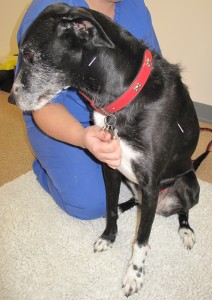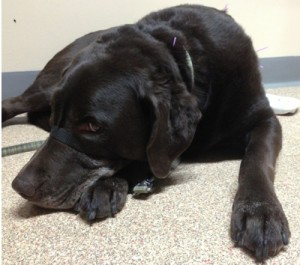
Canine acupuncture patient with needles inserted
There are two approaches to the teaching and theory of acupuncture (AP):
- Traditional Chinese medicine (TCM)
- The Western scientific approach
The Western Scientific definition of acupuncture is…
“A therapeutic modality involving insertion of needles using knowledge of anatomy, physiology, pathology & evidence-based medicine”.
TCM sees the body as having two opposing forces, Yin and Yang, which must be in balance. If disease is present, there is an imbalance of these two forces. This imbalance leads to a blockage of energy flow (Qi, pronounced Chi) around the body. Qi flows along energy pathways known as meridians, of which there are 12 with over 2000 acupuncture points along these meridians.
There are two main types of needling techniques used in animals:
- Basic dry needling
- Electroacupuncture
Any form of needling should result in a sensation around the needle – this sensation is called De Qi. It can be warmth, tingling, heaviness or dull ache, but can sometimes be uncomfortable. People often comment that they feel sleepy, tired or relaxed after acupuncture and many people get a buzz from it. Most animals receiving acupuncture become calm and some may even become sleepy.
In electroacupuncture (EAP) a current is applied between a pair of needles. The ‘dose’ of acupuncture can be varied depending on the degree of stimulation applied to the needles. This can be done during dry needling by manually stimulating the needle. EAP is considered the gold standard for stimulation and is the form of AP endorsed by the National Institute for Clinical Excellence (NICE).
Stimulation of endorphin, enkephalin & dynorphin release
These chemicals are known as the endogenous opioids – the body’s own pain killing mechanism. This is the main mechanism by which acupuncture produces pain relief. The mesolimbic loop of analgesia is an area in the brain that is probably responsible for the pleasurable feeling that people get with acupuncture.
The gate theory of pain
The gate theory of pain is a long-standing theory proposed by two eminent scientists, Melzack & Wall. It relies on the different speeds as which nerves conduct. Pain sensing fibres, called C fibres conduct their signal from the painful area into the spinal cord. They do this relatively slowly. Larger fibres, responsible for transmitting the first sensations of pain, known as A delta fibres, conduct at a much faster speed. By activating the A delta fibres (with an acupuncture needle) these fibres are able to over-ride the signal from the C fibres and thus close the pain gate,
This is the explanation behind why rubbing an injured area provides some relief of pain, for example if you bang your elbow, rubbing the affected area helps.
Trigger points
Trigger points are areas within muscle where damage has occurred. We often talk about having knots in our backs – these are examples of trigger points. In many patients suffering from pain, this is due to adaptations that the animal makes to compensate for an injury. Dogs with problems in their back legs will often develop trigger points in their back muscles because of the way they walk.
Placing a needle into and around trigger points is a well-known means of dispersing and treating trigger points.
Stimulation of local blood flow
Is thought to initiate or catalyse the healing process. AP is indicated in stimulating would healing.
Using acupuncture in veterinary practice

Labrador receiving acupuncture as part of an arthritis management protocol
It is very easy to be sceptical about acupuncture – until you try it yourself! My main use for acupuncture is in chronic pain management. These dogs and cats are suffering with longstanding painful conditions. Often these conditions are not responsive to many of the drugs we commonly use. For these patients acupuncture can be of real benefit, improve comfort and reduce reliance on medication – however I most commonly used acupuncture alongside pain killers to gain the best result for the animal.
Acupuncture is given as a course of treatment – once a week for four weeks. Some pets respond after the first session and some take all four sessions to respond. Thereafter, the frequency of treatment depends on the response of the individual animal. Acupuncture is performed during a consultation – so you will be present during the session – which lasts from 20-30 minutes.
Acupuncture for pets can only be performed by a vet. To find a vet who practices acupuncture visit www.abva.co.uk.
 The Veterinary Expert| Pet Health
The veterinary expert provides information about important conditions of dogs and cats such as arthrits, hip dysplasia, cruciate disease, diabetes, epilepsy and fits.
The Veterinary Expert| Pet Health
The veterinary expert provides information about important conditions of dogs and cats such as arthrits, hip dysplasia, cruciate disease, diabetes, epilepsy and fits.
 The Veterinary Expert| Pet Health
The veterinary expert provides information about important conditions of dogs and cats such as arthrits, hip dysplasia, cruciate disease, diabetes, epilepsy and fits.
The Veterinary Expert| Pet Health
The veterinary expert provides information about important conditions of dogs and cats such as arthrits, hip dysplasia, cruciate disease, diabetes, epilepsy and fits.